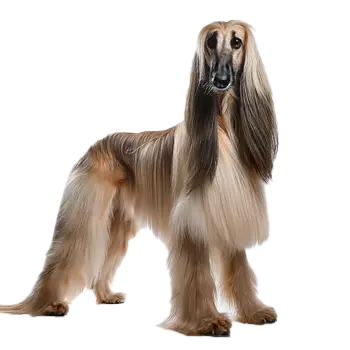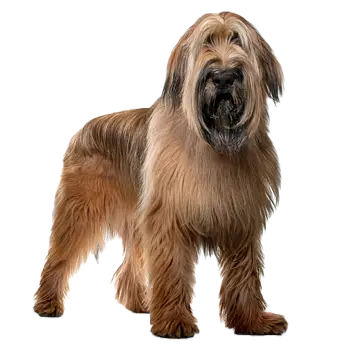Afaird
Hybrid Breed Description
The Afaird is a cross between the Afghan Hound and the Briard. Because each hybrid inherits a unique combination of traits from both parents, we recommend thoroughly researching both breeds before choosing an Afaird. Pay special attention to temperament, health issues, and care requirements, as your dog may express characteristics from either parent breed.
Afghan Hound

The Afghan Hound presents as a tall, elegant sighthound standing 25 to 27 inches at the shoulder, with males typically reaching the upper end of this range. Despite their impressive height, these dogs maintain a remarkably lean physique, weighing only 50 to 60 pounds, creating a graceful silhouette defined by prominent hipbones, an arched neck, and long legs. Their unique build features large paw pads originally evolved for shock absorption on rocky mountain terrain, while their distinctive tail curves upward into a ring shape at the tip. The breed's profile showcases high hipbones and a head held proudly, contributing to their aristocratic bearing. The most striking feature of the Afghan Hound is undoubtedly its spectacular coat of long, fine, silky hair that flows luxuriously when the dog moves. Dense coverage adorns the head crown, forequarters, chest, flanks, hindquarters, and legs, while the face and back saddle area feature shorter, glossy hair that creates an attractive contrast. A long topknot crowns the head, while the ears are draped with even longer flowing hair. The coat displays an impressive color palette including black, cream, red, blue, brindle, domino, or white, with many beautiful variations possible. The refined head features a long muzzle with a slight convex bend, complemented by dark, almond-shaped eyes that seem to gaze into the distance with an expression that appears to see beyond the present moment.
Key Characteristics
Afghan Hounds possess a temperament characterized by dignity, independence, and aloofness that has earned them comparisons to feline behavior. While they can appear standoffish and reserved with strangers, they form deep, lasting bonds with their families and display profound loyalty to their chosen people. These dogs exhibit a fascinating duality in personality—simultaneously regal and dignified yet capable of delightful playfulness and clownish behavior, particularly during interactions with trusted family members. Their affectionate nature emerges fully with those they love, though they maintain their characteristic reserve in unfamiliar situations. Originally bred for independent hunting across challenging mountainous terrain, Afghan Hounds display strong-willed and self-confident behavior that can make training a considerable challenge. They possess high intelligence but rank low in obedience intelligence due to their independent thinking rather than lack of ability. These sensitive dogs respond poorly to harsh corrections and require patient, gentle training approaches using positive reinforcement techniques. Their powerful prey drive means they will chase small animals if given opportunity, necessitating secure fencing and careful management. Afghan Hounds are generally gentle souls who can coexist peacefully with children and other pets when properly socialized from puppyhood. However, they tend to be wary of strangers and slow to extend trust beyond their immediate family circle, making extensive early socialization essential to prevent excessive timidity or suspicion. These dogs require understanding owners who appreciate their unique combination of elegance, independence, and occasional silliness.
Afghan Hounds face several hereditary health concerns that prospective owners should understand. Hip dysplasia represents a significant issue where the hip joint develops abnormally, potentially leading to arthritis, discomfort, and reduced mobility as the dog ages. Eye conditions pose another concern, with the breed showing increased susceptibility to juvenile cataracts and progressive retinal atrophy that can impact vision quality. Autoimmune thyroiditis affects some Afghan Hounds, causing inadequate thyroid hormone production that may manifest in skin problems, weight fluctuations, and behavioral changes requiring lifelong management. With proper care and attention, Afghan Hounds typically enjoy lifespans of 12 to 14 years. The breed shows heightened risk for hemangiosarcoma, a serious tumor type that commonly develops in the spleen and can grow quite large before producing noticeable symptoms. Regular senior wellness testing becomes crucial for early detection of this condition. Bloat, or gastric dilatation volvulus, presents a life-threatening emergency where the stomach fills with gas and may twist, cutting off blood circulation and requiring immediate veterinary intervention. This condition occurs more frequently in deep-chested breeds like the Afghan Hound. Regular preventive veterinary care and health screenings help Afghan Hounds maintain quality of life throughout their years. Dental disease affects this breed more than average, starting with tartar buildup and potentially progressing to damage internal organs if left untreated. The breed displays unique responses to anesthesia due to their lean body composition and sighthound physiology, requiring veterinarians experienced with breed-specific considerations. Responsible breeders conduct health screenings and provide documentation of genetic clearances for breeding stock, helping reduce the incidence of hereditary problems in future generations and producing healthier puppies.
Briard

The Briard presents as a substantial, powerfully built herding dog with males standing 23 to 27 inches at the shoulder and females measuring 22 to 25.5 inches tall. Weight ranges considerably, with females typically weighing 50 to 70 pounds and males weighing 65 to 90-plus pounds, though most modern representatives trend toward the larger end of the spectrum. The voluminous coat makes these dogs appear even more substantial than their actual weight suggests. Their muscular body is built for tireless work, featuring well-developed shoulders that meet strong front legs and a robust neck that carries the head proudly. The overall build shows a slight rectangular proportion with body length slightly exceeding height, creating the ideal structure for efficient trotting over long distances while herding flocks. The Briard's most defining characteristic is its long, wavy double coat composed of coarse outer hair and fine, tight undercoat, with hair length reaching at least six inches. The coat texture resembles goat hair and naturally sheds dirt and water, providing excellent protection from the elements. All uniform colors are acceptable except white, including black, gray, and various shades of tawny, with some individuals developing attractive silver or gray highlights as they mature. The large, rectangular head features high-set ears covered in long hair that creates a distinctive sail-like appearance. Bushy eyebrows often cover dark brown or black eyes, while a luxurious mustache and beard frame the square muzzle with its prominent black nose. The breed displays several unique identifying features including a long, well-feathered tail ending in a characteristic J-shaped curve called a crochet, which serves as a hallmark of the breed. Perhaps most distinctive are the double dewclaws on each hind leg, positioned low enough to function as actual toes. The breed moves with a supple, powerful gait that has been described as gliding over the ground, combining the grace of a large feline with the strength of a working dog.
Key Characteristics
Briards possess hearts truly wrapped in fur, displaying intense devotion and loyalty to their families combined with natural protective instincts toward those they love. Often described as having spirit, initiative, wisdom, and fearlessness, these intelligent dogs form profound emotional bonds with family members and remain highly sensitive to their owners' feelings and needs. They seek constant companionship with their human pack and thrive when included in family activities, making them poorly suited to isolation or kenneling. While affectionate and gentle with loved ones, Briards maintain a reserved and watchful demeanor with strangers, making them excellent guard dogs capable of discriminating between situations requiring protection and those that don't. The breed exhibits considerable independence and strong opinions about how things should be done, characteristics stemming from centuries of making autonomous decisions while herding and protecting flocks. Briards can be manipulative, pushy, and stubborn alongside their endearing qualities of being entertaining, funny, and remarkably sweet. They require consistent leadership with clear boundaries and respond best to owners who earn their respect through fair, patient training using positive reinforcement techniques. These highly intelligent dogs learn quickly but may choose to question or refuse commands if they disagree with their handler's decisions. Their herding instincts sometimes manifest as attempts to herd family members, particularly children, which requires early training to redirect appropriately. Briards need significant mental and physical stimulation to prevent destructive behaviors such as chewing, digging, or excessive barking. Without adequate outlets for their considerable energy and intelligence, these active dogs will create their own entertainment, often in ways owners find unacceptable. Early and extensive socialization proves essential since their default setting is to love and trust only familiar people and situations. With proper training and socialization, Briards make devoted family companions who excel at various dog sports and working roles while maintaining a playful, lively spirit throughout their lives.
Briards face several hereditary health conditions that responsible breeders screen for before breeding. Hip dysplasia occurs in approximately 17 percent of the breed, where the hip joint develops loosely, causing pain, lameness, and eventual arthritis that can significantly impact quality of life as dogs age. Elbow dysplasia similarly affects joint development in the front legs, potentially causing chronic discomfort. These orthopedic issues can be managed through weight control, appropriate exercise, and in severe cases, surgical intervention. Eye diseases also affect the breed, including cataracts, progressive retinal atrophy, and congenital stationary night blindness—an inherited condition causing varying degrees of vision impairment in low light that requires DNA testing to identify carriers in breeding programs. Briards typically enjoy lifespans of 10 to 12 years when provided with appropriate care, nutrition, and regular veterinary attention. The breed shows susceptibility to bloat or gastric dilatation volvulus, a life-threatening emergency where gas accumulates in the stomach and may cause it to twist, cutting off blood circulation and requiring immediate surgical intervention. This condition occurs more frequently in large, deep-chested breeds and represents one of the most serious acute health threats. Hypothyroidism affects some Briards, manifesting in symptoms including dry skin and coat, hair loss, weight gain, and behavioral changes that require lifelong hormone replacement therapy. The breed also faces increased risk for certain cancers including lymphosarcoma, making early detection through regular veterinary examinations crucial for successful treatment outcomes. Additional health concerns include von Willebrand's disease, a bleeding disorder that affects blood clotting ability, and various skin and allergy problems that can cause itching, recurrent ear infections, and digestive issues. The breed's long, dense coat requires meticulous grooming to prevent mats that can lead to painful skin infections. Regular dental care is essential as dental disease affects a high percentage of dogs regardless of breed. Responsible breeders provide comprehensive health clearances from organizations like the Orthopedic Foundation for Animals for hips, elbows, and thyroid function, along with eye certifications from the Canine Eye Registry Foundation, helping prospective owners select healthy puppies from lines with demonstrated lower incidence of genetic problems.
Important to Remember
Each hybrid dog is unique and may inherit any combination of traits from either parent breed. The information above represents the characteristics of the purebred parent breeds. Your Afaird may favor one parent over the other or display a blend of both. We strongly encourage you to read the complete breed profiles for both the Afghan Hound and Briard to fully understand the range of possible temperaments, health concerns, and care requirements.